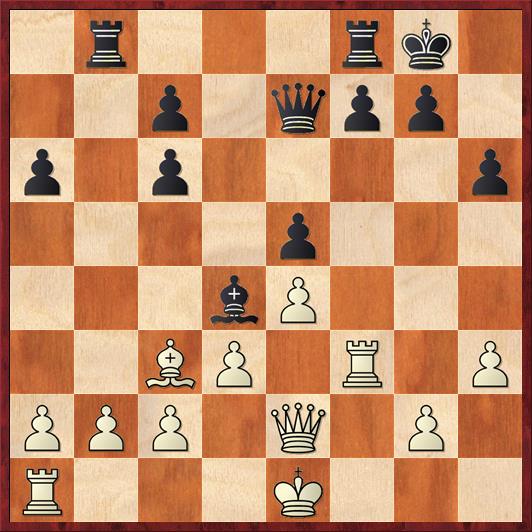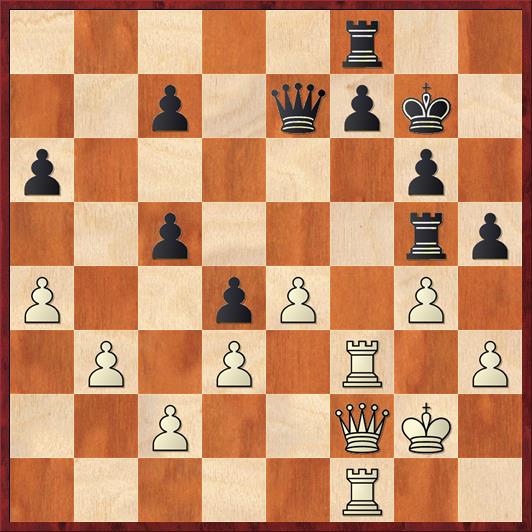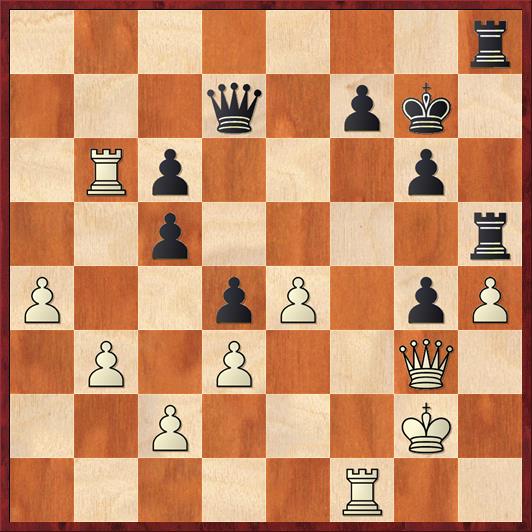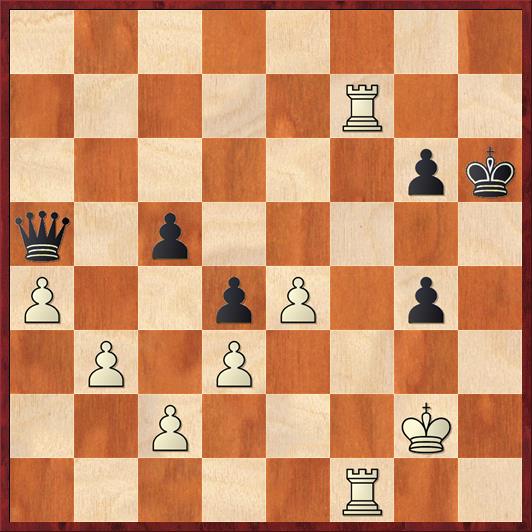Last night, in the fourth round of the Kolty Club Championship, I was paired against an expert, Chris Atkeson. We played what I think was a really high-quality game… and as it usually happens in games where nobody makes an obvious mistake, we drew. It was a draw that both players were happy with (at least initially). I was happy because in the early middlegame I seemed to be in great danger of being blown out. Yet somehow my dubious-looking position got better and better, and near the end of the game I thought I was probably winning. But Atkeson fought hard to the end and managed to get a draw by perpetual check.
When I went over the game on the computer, I was stunned to see how close we came to perfect play, according to Rybka. Over the last 16 moves, every move I played was in the top three choices of the computer. (Nevertheless, I think that my 30th move was a blunder that cost me a win.) Atkeson did even better. Fourteen of his last 16 moves were the #1 choice of the computer. Of the two “mistakes,” one was in my opinion not a mistake. And the other “mistake” was, from a practical standpoint, the game-saving move. He chose to play actively rather than defending a bad position, and that decision was eventually rewarded with a draw. So it’s hard to say how he could have improved his play.
And with that, I offer a puzzle for my readers. On move 21, Rybka says the position is equal. Black then plays seven straight moves that Rybka considers to be the best move. At the end of those seven moves, Black is nearly lost. What did he do wrong? And what is Rybka missing?

FEN: 1r3rk1/2p1qpp1/p1p4p/4p3/3bP3/2BP1R1P/PPP1Q1P1/R3K3 w Q – 0 17
Let’s start a bit earlier, in the position where I first felt as if I was in trouble. I was White in a King’s Gambit Declined. Black’s move 16. … Bd4 didn’t bother me until I realized that my intended defense, 17. Qd2?, allows the strong exchange sac 17. … Rxb2! 18. Bxb2 Bxb2 19. Rb1 Qa3. Black gets two pawns for the exchange and the passed a-pawn looks as if it will be very hard to stop.
So I had to go to plan B, which was 17. Bxd4 ed 18. b3 (groan). I think that b3 for White (and … b6 for Black) must be the one chess move that is most frequently played with a sour expression on one’s face. It means that you can’t find enough compensation to sacrifice the b-pawn, and all the defensive moves (here, O-O-O or Rb1) are too passive. So you have to play this move b3 that leaves your pawn structure full of holes.
Here Atkeson decided not to play 18. … Qa3, which surprised me. After that my plan was to sac the a-pawn with 19. Qd2 Qb2 20. Rc1 Qxa2 21. Rf5, but unfortunately 21. … Rb5 is quite good and leaves Black a solid pawn up. Rybka says that White’s best defense after 18. … Qa3 is 19. Rf1!, after which 19. … Qb2 20. Kf2! accomplishes nothing for Black.
Maybe that’s why Atkeson chose 18. … Rb5 instead. I was glad to play 19. a4 so that I wouldn’t have to worry any more about … Qa3. Atkeson played 19. … Re5. White’s position still looks tenuous. I can’t ever castle queenside because of … Qa3+ followed by … Rb8 with a mating attack. I sure don’t want to keep my king in the center, either. But first I decided to see if I could slow down Black’s attack with 20. g4.
Chris actually said that he missed this simple, logical move, and perhaps that shows in his next move, 20. … g6?! He is still trying to force the advance … f5, but the cost is too high because after an exchange of g-pawns he will be vulnerable on the g-file. He should have changed to a different plan, perhaps 20. … h5 immediately, with play similar to the game except that Black doesn’t have the weak square on f6.
I want to point out again that even after this move, Rybka rates the position as only +0.1 for White – very close to dead equality. Nevertheless, within 10 moves Black will be nearly lost, without making any obvious mistakes.
Play continued 21. Kf1 h5 22. Qf2 c5 23. Kg2 Kg7 24. R1f1! (diagram)

FEN: 5r2/2p1qpk1/p5p1/2p1r2p/P2pP1P1/1P1P1R1P/2P2QK1/5R2 b – – 0 24
At this point I started feeling bullish about my position again. This is exactly what you play the King’s Gambit for: to get a half-open f-file with tripled major pieces on it! But, of course, king safety is an issue, and Chris immediately targets my king.
24. … Rg5 25. Rf6! …
I was getting really low on time now, but this move was a no-brainer. It’s worth a pawn to cement my control over this square – and besides, there are a lot of weak pawns in Black’s position too.
25. … hg 26. h4 Rh5 27. Qg3 …
I wasted a precious minute debating between Qg3 and Qf4, and finally opted for the safer-looking move. Rybka says it doesn’t really matter, and I just wasted my minute.
27. … Qd7
Sensible, but now the a-pawn goes.
28. Rxa6 c6
For a second I thought, “Oh no! I’ve self-trapped my rook!” But it’s easy to protect it with Rb6 and a5.
29. Rb6 …
And now Chris makes the decision that saves the game, even though Rybka says it’s a blunder.
29. … R8h8!?!

FEN: 7r/3q1pk1/1Rp3p1/2p4r/P2pP1pP/1P1P2Q1/2P3K1/5R2 w – – 0 30
For context, you have to realize that Rybka thinks Black should play lame defensive moves like … Rc8 or … Ra8. But that’s just playing to lose, or to suffer a long time. I would make the same move Chris did, in a heartbeat. Nevertheless, it must be conceded that Black is losing, so the question definitely has to be asked: What did he do wrong?
30. Qf4? …
Another paradox! Rybka considers this move to be equally as strong as 30. a5, but they are not equal. The move 30. a5! tips the balance in White’s favor: while we have roughly a standoff on the kingside, the passed a-pawn is a new weapon on the board. If 30. … Rxh4 31. Qe5+ Kh7 32. a6! threatening Rb7. Or if 30. … Qe7 (to prevent Qe5+) 31. a6 Rxh4 32. Rxf7+! followed by 33. Rb7 is a gut shot into Black’s position. I think it’s an exquisite fact that the piece that gives White a winning attack on the kingside is the most distant piece on the board, the a-pawn.
In my defense, I was very low on time now (5 minutes for the rest of the game). The immense power of this previously irrelevant a-pawn was not obvious, and 30. Qf4 looked very strong too. But now Black can play the line in the previous note without having to worry about Rb7.
30. … Qe7! 31. Rxc6 Rxh4 32. Qf6+ …
Now I was under 5 minutes on the clock, and this move seemed to make much more sense than going for an unclear endgame of Q vs. 2R with 32. Rf6 Rh2+ 33. Qxh2 Rxh2+ 34. Kxh2. Rybka rates the resulting position at +1.8 (!) for White, but I am far from convinced that White is winning. After, say, 34. … Kh6! (an important wrinkle) 35. Kg2 Qc7 36. Rxf7 Qa5 (diagram), can White really win this? There are so many dark squares where Black’s queen can penetrate, and also if the queen ever gets to h3 it’s an instant perpetual. Also, Black’s king has a perfect little hidey-hole on g5 where he can’t be harassed by the rooks.

FEN: 8/5R2/6pk/q1p5/P2pP1p1/1P1P4/2P3K1/5R2 w – – 0 37
Even though Rybka still says White is +1.6, I don’t believe it. And I don’t want to play an endgame like this in a time scramble where I have 5 minutes and my opponent has 30.
32. … Qxf6 33. R6xf6 Rh2+ 34. Kg3 R8h3+ 35. Kxg4 Rh4+ 36. Kg3 R4h3+ 37. Kg4 ½-½.
So: What did Black do wrong? For me, of course, it’s more relevant to ask what White did wrong. I drew this game because I did not have a winning mindset. I took way too long in the opening (47 minutes for the first 10 moves) even though it’s one I should know. And then on move 17, the one this post started with, I took 24 minutes, which was ridiculous. Yes, I had to process the shock of realizing I was in trouble, but that shouldn’t take 24 minutes. As a result, when we got to move 30 — a position where I had to think creatively and deeply — there wasn’t enough time to do it.
After four rounds of the tournament, we have a clear (and surprise) leader, class-A player Eric Steger, who beat Juande Perea to go to 4-0. What a sensational start for Eric! As the number 13 seed, he has already beaten the #2 seed (Wladimir Getselevich) and the #3 seed (Perea). Next week he will have a chance to make it a trifecta, because he will probably be paired against the #1 seed, Mike Splane. The standings are:
- Eric Steger (4-0)
2-4. Mike Splane, Paulo Santanna, Michael Ho (3½-½)
I’m in a five-way tie at 3-1. We have a week off for Thanksgiving, so I’ll be back with an update in two weeks.



{ 3 comments… read them below or add one }
Great to see the blog back and active, taking a look at tournament games and other things helpful and relevant for improving players.
To see if there was a difference using a modern engine vs. Rybka’s evaluation, I plugged the position after 20…g6?! into Komodo (11.2). From previous equality, it immediately showed a White plus of over 0.3, which after five minutes or so of crunching evolved to over 0.6 after the engine’s choice of 21. Qd2. The actual game move 21. Kf1 put it back to equality (assuming Black plays …f5 in response). However, after 21…h5 22. Qf2! and Komodo shows 0.6 for White again. It certainly looks like moves 20-21 were the critical turning point.
Dana,
Your blog is so original and so instructive, but for a player at my level each one is very hard to get through time-wise.
My question is this: will I always have access to your old posts via your home page? I am having to clean up my gmail inbox because I am running out of space. Each of your emails to me is essentially a link to one of your posts, with a title.
And, God forbid, Dana, that you retire someday from writing your blog. I hope that you would be able to maintain the site for posterity, or accumulate your posts as a book, or as a giant downloadable .pdf file. It would be a shame for the chess world to lose such a unique resource.
I ran into you once at the Aptos Library, and you told me Magnus Carlsen would be having an event in San Jose; thanks to you I was able to attend and lay eyes on him. Wow.
Thank you, Dana, from a patzer who admires your work.
Tom Johnson
thomasjohnsonmd@gmail.com
Thanks to both of you for your great comments! Yes, my Rybka is looking pretty outdated these days. I think I’m stuck with it while I use my old laptop. However, this fall I got a new desktop (a Mac), and I should really look for some good chess software for that. What is the best chess program in Apple-land these days?
To Tom, Although my blog productivity has slowed down a bit I have no intention of stopping it. I appreciate your support. Every comment like this means something to me!